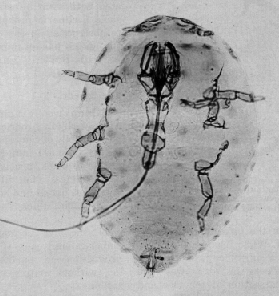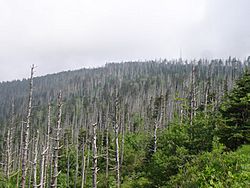Balsam woolly adelgid facts for kids
Quick facts for kids Balsam woolly adelgid |
|
|---|---|
 |
|
| Adult Balsam woolly adelgid | |
| Scientific classification | |
| Genus: |
Adelges
|
| Species: |
piceae
|
The balsam woolly adelgid (Adelges piceae) is a tiny, wingless insect. These insects attack and kill fir trees. They especially harm balsam firs and Fraser firs.
Balsam woolly adelgids are an invasive species. This means they are not native to the place where they now live. They came from Europe and were brought to the United States around 1900. Because they are new to the U.S., trees like the Fraser fir have no natural way to defend themselves against them.
How Balsam Woolly Adelgids Reproduce
These tiny insects lay about one hundred eggs at a time. They can have three new groups of babies each year. The adelgid attacks trees by feeding in small cracks in the bark. They prefer trees that are wider than about four centimeters across.
As an adelgid feeds, it releases a special liquid called toxin from its saliva. This toxin makes it hard for the tree's sapwood to carry water. Sapwood is the part of the tree that moves water and nutrients. When water can't move well, the tree gets very thirsty and eventually dies.
Impact on Fir Forests
The Great Smoky Mountains National Park is a large park in North Carolina and Tennessee. It has about 75% of all the southern spruce-fir forests. These special forests used to cover huge areas of the Southeast during the last ice age. Back then, the weather was cool and wet.
After the glaciers melted, these forests became much smaller. They are now found only on the highest parts of the mountains. These spruce-fir forests are like islands, separate from other similar ecosystems. This makes them unique and important for research. These forests have a very thick canopy (the top layer of tree branches). They also have a moist understory (the plants growing below the trees).

The balsam woolly adelgid was first found in the Great Smoky Mountains in 1957. Since then, 90% to 99% of Fraser firs have died. Even though some young firs are growing back, the plants on the forest floor are changing. New types of plants are moving in.
Red Spruce trees also live in these forests. They have been declining too. Some scientists think this is because the firs, which usually block strong winds, are gone. The balsam woolly adelgids destroyed about 95% of the Fraser firs in the park. This created "ghost forests" of dead trees. By 2020, the number of older firs compared to young firs had increased. For example, Clingmans Dome had three times more adult trees in 2020 than in the 1980s.
Some people worry that acid rain and other pollutants are making Fraser firs weaker. This might make them more likely to get sick from the adelgids. The Spruce-fir moss spider is an endangered animal. It lives on moss under the forest canopy. Its survival is threatened because the Fraser firs are dying.
The balsam woolly adelgid also harms forests in the Pacific Northwest. This includes trees like grand fir, silver fir, and subalpine fir. These trees grow in Washington and Oregon. Many trees died in the Cascade Mountain range in the 1950s and 1960s because of this pest. The area affected by the adelgid in the Pacific Northwest has grown. It increased from about 83,325 acres in 2004 to 108,128 acres in 2005.

